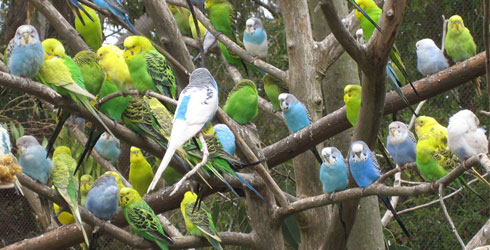Melopsittacus undulatus (budgerigar)
Budgerigars are one of the world’s best-loved birds. They are hugely popular in captivity for their hardy nature, engaging behaviour and wide range of attractive colours.
But behind the diversity of modern captive birds is one species of small Australian parrot, superbly adapted for life in one of the world’s toughest environments.
The history of the discovery of the budgerigar and its development in captivity provides fascinating insights into both natural and artificial selection - a modern equivalent to Charles Darwin’s fancy pigeons.
Species detail
-

Taxonomy
Find out when budgerigars were first described and how wild budgies are characterised by their plumage.
-

Distribution
Melopsittacus undulatus is native to Australia. Find out where wild budgies live and how they have adapted to their habitat.
-

Biology
The birds nest communally. Mating pairs use suitable holes in tree trunks or branches for their nest. Find out more.
-

Behaviour and conservation
Budgerigars are very sociable and in the wild they fly in large flocks. They exhibit social behaviour such as mutual preening and when kept in captivity, even preen their owners. Find out more.
-

Aviculture - budgerigar breeding
Budgies were first brought to Britain in 1840. Since then they have been bred in all shades and sizes. Read on to discover how budgerigar breeding has developed in the last 170 years.
-

References
Get reference material on the budgerigar.
Images

Budgerigar chick at 11 days old.
© smartneddy, Creative Commons Attribution-Share Alike 2.5 Generic
An early specimen of budgerigar from John Gould, labelled ‘budjeregah’.
© Harry Taylor, Natural History Museum
A multi-coloured flock of captive budgerigars.
© Anna Saccheri, Creative Commons Attribution-Share Alike 2.0 Generic
A multi-coloured flock of captive budgerigars.
© Anna Saccheri, Creative Commons Attribution-Share Alike 2.0 Generic
An early wild green budgerigar compared to a ‘violet’ specimen from the 1950s.
© Harry Taylor, Natural History MuseumAbout the author
A word from the author
"Budgies are so familiar it’s easy to overlook them and forget how interesting they are. If Charles Darwin was working today, I like to think budgies, not pigeons, would provide his inspiration!"

